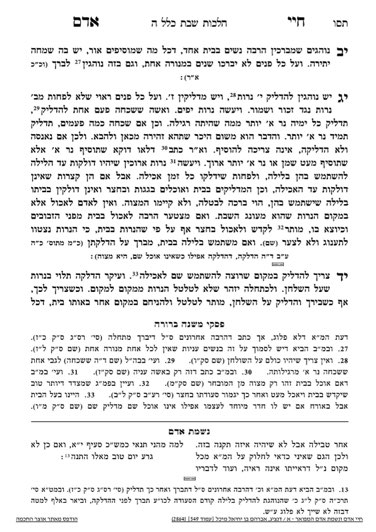We are continuing in siman 13. The Chayei Adam writes that the purpose of the neiros is to enhance the meal, so preferably they should last throughout the meal. Furthermore, if one makes early Shabbos, the neiros should last until nighttime, because the point is to light up the home when it is dark, not when there is still sunlight.
If the neiros are small, if they last long enough to enable food preparation for the meal, the Mishnah Berurah writes that bedieved it is sufficient.
The Chayei Adam continues, and writes that if the family plans to eat outside (which was commonly done when it was hot), and the neiros are lit inside, the neiros do not contribute anything to Shabbos. It is considered a bracha levatala and they have not fulfilled the mitzvah. In such a case, the neiros must last long enough that the family derives benefit from them when the return home after the seuda.
We have discussed that, given electric lights, the bracha should be made in conjunction with one’s electric lights as well. Thus, if one eats out, even if their neiros are extinguished, their bracha is fulfilled through the electric lights and they do not have an issue of a bracha levatala.
The Chayei Adam continues, and writes that part of oneg Shabbos is to be able to see one’s food. Therefore, a person should not leave a lit room in order to eat in a dark place. For example, if one lit their neiros inside, where it is hot, but wishes to eat outside, where there is a breeze but it is dark, we have a conflict. A person should preferably eat inside the house. However, if one is experiencing significant discomfort, such as that there are many flies in the house, one may eat outside. The purpose of the neiros is oneg Shabbos, so if insisting on eating by the neiros is decreasing oneg Shabbos, it does not make sense to do so.
If the neiros will be helpful for preparing the meal, or they will last until after the meal when one returns to the home, one may make a bracha on the neiros. Otherwise, one cannot make a bracha on them.
When discussing a person who wishes to eat outside, the Chayei Adam specifically uses the language that it is muttar to make kiddush and eat outside. We will learn that kiddush b’makom seuda prohibits one from making kiddush inside and moving outside aftwards. Thus, the Chayei Adam is clarifying that he is not discussing a case of moving after having begun the seudah, because that would be problematic.
Summary
- The neiros need to contribute in some way to oneg Shabbos. Ideally, they contribute by lighting up the seudah, but if one is not eating by the neiros, they should contribute either by enabling food preparation before the seudah, or by staying lit long enough that they are still lit when the family returns home after the seuda.
- If one does not derive even these minimal benefits, one cannot make a bracha on them.
- Nowadays, if one has in mind their electric lights, the bracha can go on the electric lights.
- Although one should eat by the neiros, if their oneg Shabbos is decreased by eating there, they may eat elsewhere.



